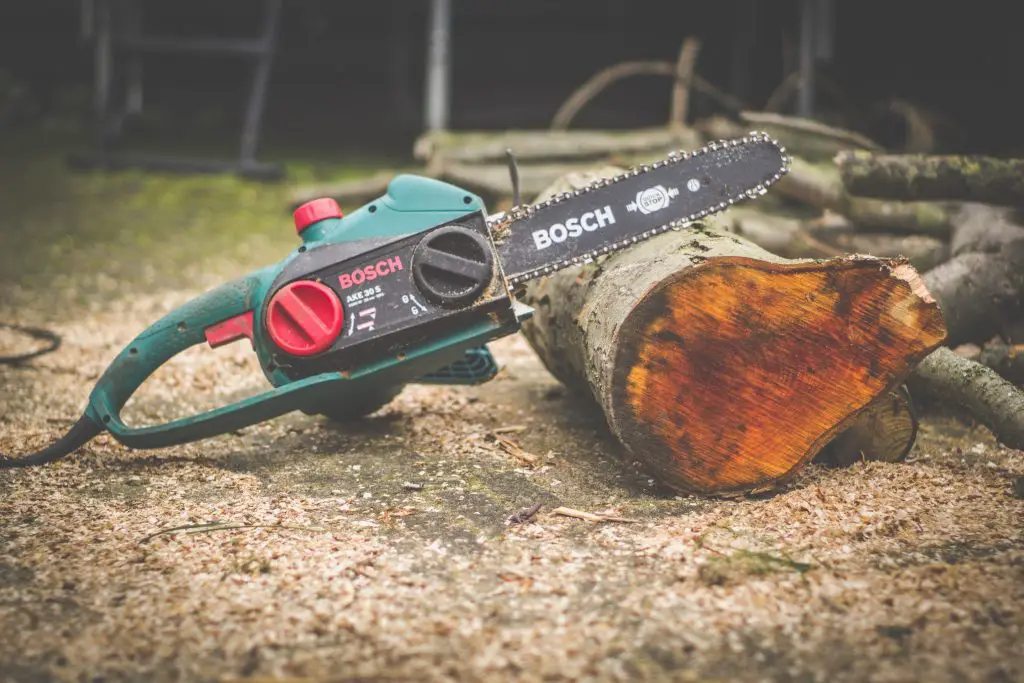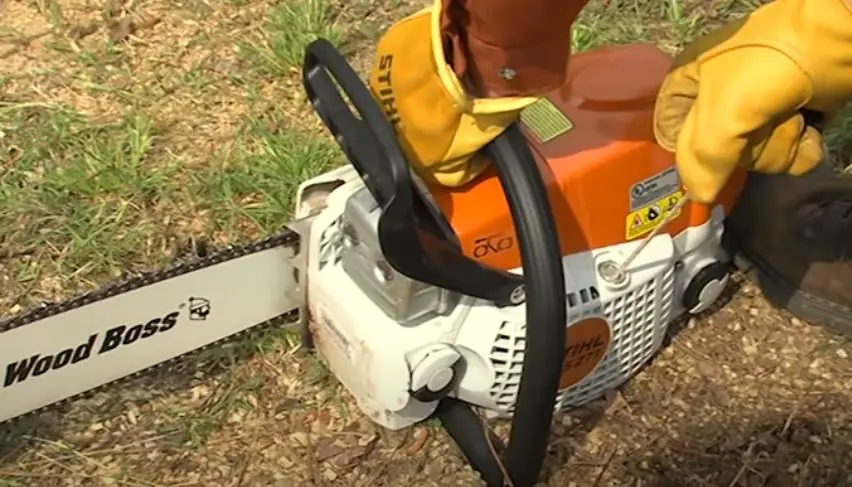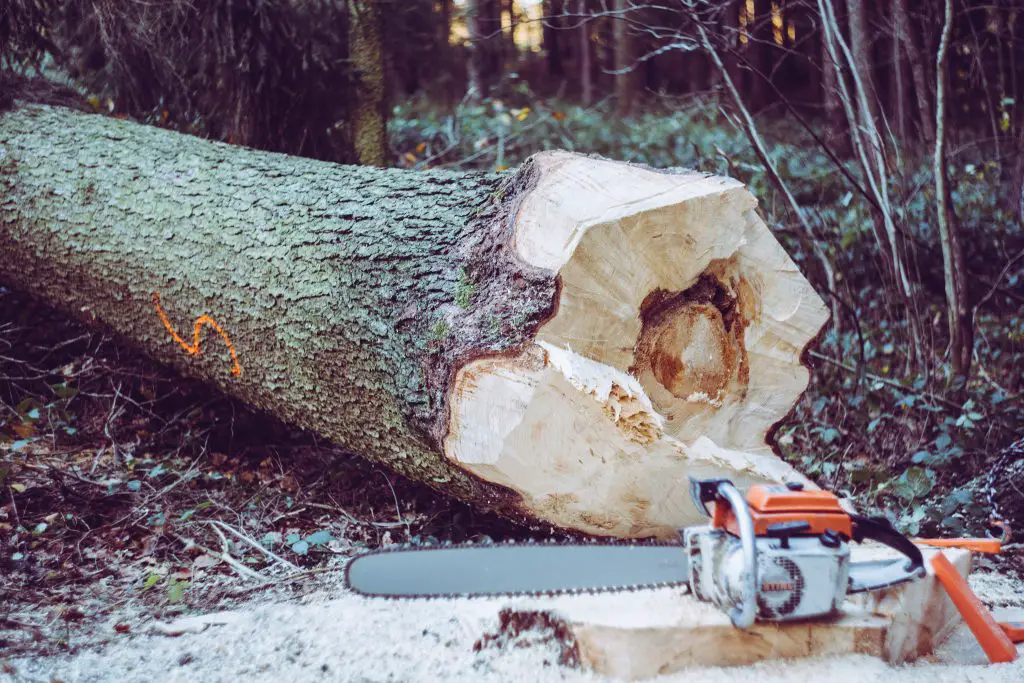To use a chainsaw, follow these steps:
- Wear protective gear
- Fill oil and fuel tanks
- Start the chainsaw on a stable surface
- Hold the chainsaw firmly with both hands
- Engage the throttle and chain brake as needed
- Cut with the lower part of the bar to avoid kickback
- Maintain control and proper body positioning.
A chainsaw cuts wood with amazing speed and precision, but things can get ugly if you’re not careful. Working with power tools can be intimidating, but if you know how to handle your chainsaw, you can do all your pruning, limbing, bucking, and woodworking projects quickly.
You don’t have to go through the process of trial and error. I did when I got my first chainsaw, but I’m ready to save you all the hassle and explain how to use a chainsaw.
In this article, I’ll walk you through the basics and process of operating the chainsaw to get you started.
Table of Contents
Step 1. Prepare Your Chainsaw
A chainsaw is a power tool that features a fast-moving chain, which moves around a guide bar. It’s one of the strongest and handiest power tools and can also be dangerous if it’s in the wrong hands.
To start your cutting game, you need to prepare your chainsaw correctly. You must think about a few things if you’re using your first chainsaw.
Feel confident about the tool
Fear can confuse you and cause you to mishandle the chainsaw. If you can’t handle the tool confidently, you’d better call a professional to finish the job.
Pick the right chainsaw
Selecting the ideal chainsaw for your needs and frame is crucial.
A lighter chainsaw will be your best friend if you’re a beginner using this tool for the first time.
A heavier chainsaw will be more versatile, but you might not need it if you’re only doing minor cutting projects around the garden.

Check all parts are properly installed and lubricated
Check out that the chainsaw’s teeth are as sharp as possible. If it’s a new chainsaw, the teeth will be ready, but if it’s an old one, you must sharpen them first.
Make sure that the chain is set at the correct tension. You should also make sure that there are no loose parts.
Safety First
Scan the work area and make sure that there are no obstacles around the work area. Other people, especially children, shouldn’t have access to the work area.
Always hold your chainsaw firmly with both hands and ensure the tip doesn’t touch anything before you start.
Step 2. Wear Your Safety Equipment
No matter how experienced you think you are, accidents can happen while using a chainsaw. This is why you need to wear the proper protective gear.
Always wear a protective helmet while using a chainsaw, especially if pruning a tree. Falling branches represent a real hazard.
Use hearing protection
While you might not think that your chainsaw is too loud, continuous exposure to loud noises leads to hearing loss and other issues in the long run.
Wear protective goggles to protect your eyes from flying debris and sawdust.
Use a neck guard
If you won’t use professional protective clothing, ensure your clothes fit right. Too tight clothes can be restrictive. On the other hand, if your clothes are too loose, they can get caught up in the chainsaw.
Wear protective boots
A non-slip outsole allows you to work on all surfaces, while a reinforced toe-cap protects your feet if something falls.
Put on protective gloves
They allow you to handle the chainsaw and protect you from minor cuts easily.
Wear chainsaw chaps, especially if you’re doing some logging work. They will protect your legs from accidental cuts.
Step 3. Start Your Chainsaw
To work perfectly, all the internal parts of the chainsaw should be warmed up before you start using it. Here’s how it’s done.
- Place your chainsaw on the ground or between your legs.
- Locate the chain brake and lock it until you can use the chainsaw.
- Start the chainsaw and let it idle for 10 minutes.
- Handle the choke position if your chainsaw has one, and then push the primer button several times to get the engine ready.
- Stabilize your chainsaw with your foot and hand and use your body weight to hold it in place.
- Pull the rope several times until the engine starts.
- Unlock the chain brake to start cutting.
- If this is the first time to use the chainsaw, start cutting your wood at three-quarters of an idle. Your chainsaw needs to go through three fuel tanks before it’s officially broken in, and you can use it at full throttle.
- An electric chainsaw is easier to start. You connect it to a power outlet or ensure the battery is charged. Then, press the power button and release the chain brake, and it will be ready to use.
I have written more about starting a chainsaw if you are having trouble.

Step 4. Felling a Tree
Most people choose to fell a tree or two for safety purposes. However, you can also choose to fall a tree for aesthetic reasons if it blocks the light or affects your landscape design.
Cutting down a tree can be easy and safe if you follow the necessary safety precautions and the right technique. Here are the steps to follow.
Get Ready for Work
Before you start, check with the local authorities if you should get a permit before cutting down a tree. Wear your safety equipment to get ready.
Clear the Area
Make sure that the area around the tree is clear. You don’t want to cut down a tree that ruins the power lines while it’s falling.
If there are too many obstacles around the tree, you’d better hire a professional to do the job on your behalf. Ensure that the tree won’t fall into another tree, which can be seriously dangerous.
Check the Tree
Check out the tree itself. A healthy tree can break unpredictably once you start cutting it. Also, if it’s leaning to one side, you won’t be able to control the direction where it falls.
Start Cutting
Remove the side branches to have more control over the fall path.
Start by cutting a notch about two feet off the ground at a 70-degree angle at the side where you want the tree to fall. Ensure the bottom is deeper than the upper part, and the notch doesn’t go more than one-third through the tree.
Make a horizontal cut one-third through the tree at the bottom of the notch. Start by lining up your chainsaw’s blade about two inches away from the notch, then inserting it to cut through the tree.
Insert a felling wedge into the cut and repeat the process on the other side. Place the chainsaw on the other side of the notch and cut through the remaining wood. As soon as the tree starts to fall over, turn off the chainsaw and walk away.

Step 5: Cut Up a Log
Cutting logs for firewood or woodwork projects seems daunting. However, this job won’t take much time or effort with the right steps.
Understanding the basics of your chainsaw operation will make bucking a straightforward task. Here are the right steps to follow.
Get Ready
Start by getting yourself and your equipment prepped for the work. You should wear your safety equipment and clear the area around the log. Next, remove all the obstacles from your work area to reduce the risk of tripping.
Start by Limbing
Remove the branches from the tree before cutting the logs. To reduce the risk of kickback, avoid using the upper tip of the blade.
Measure Your Cuts
You should measure your cuts depending on the purpose for which you want to cut the logs. For example, wood for fire and stoves should be cut into smaller pieces. For woodworking projects, the size of your cuts will vary.
Cut the Wood
Elevate your tree, if possible, and keep it steady. Set the bucking spikes near the bar into the wood and stabilize your hand as much as possible.
You might have to cut one side at a time and turn the log the other way around to avoid pinching. For larger logs, use wedges.
Chainsaw Safety Tips
Here are a few tips to ensure your safety while using the chainsaw.
- Don’t attempt to saw anything above your shoulders as it might accidentally fall and hit you on the head.
- Wrap your thumbs and fingers around the handles for a steady grip.
- Don’t let the tip of the guard bar hit anything, as it might cause a kickback.
- Hold the chainsaw close to reduce your body and stand with your feet apart for better balance.
- It’s better if you can work with a friend. If you’re working alone, carry a mobile phone or a communication radio to ask for help.
- Cut smoothly, and don’t force the blade as it might get stuck.
Chainsaw Maintenance
Regular maintenance is essential to keep your chainsaw in excellent condition. I recommend that you follow these steps regularly for a flawless performance.
- Keeping your chainsaw clean guarantees that it will always be ready for use. Remove sawdust and oil. Then, rinse all the parts and dry them completely.
- Use compressed air to remove clogs from the carburettor.
- Sharpen the blade regularly to prevent jumps.
- Always lubricate the chainsaw.
- Add new gas or a fuel additive if you don’t use the chainsaw regularly.
Wrap Up
Following this detailed guide, you shouldn’t be intimidated to use the chainsaw, even if you’re a first-timer. Working with this power tool takes confidence and a lot of practice, so take time to prepare it and wear your safety equipment before cutting any wood.
